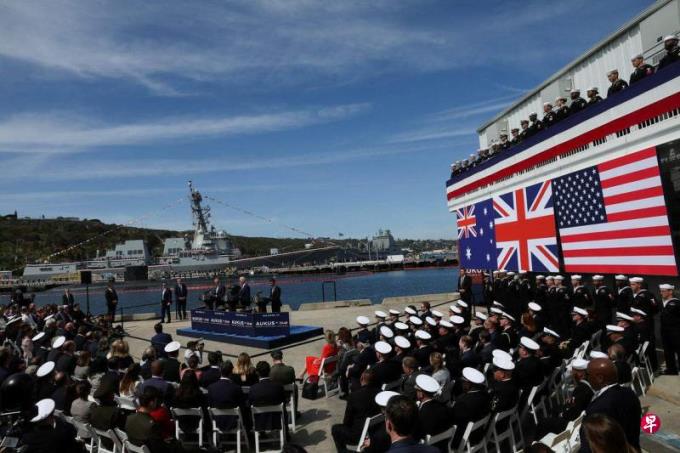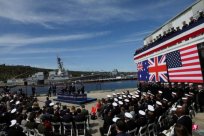
The process of building the East Asian United Front is far from over. The statement of the United States, Japan and the Philippines stated that the statement of the United States, Japan, and the Philippines were just the beginning of the cooperation of the three sides.In the long run, the United States hopes to establish a Asia -Pacific version of NATO and associate with the European NATO.
US President Biden's diplomatic cornerstone is to strengthen cooperation with the "like -minded" allies to curb potential strategic competitors.Recently, in East Asia, the cooperation between the United States and some allies has made breakthroughs. Before the US presidential election, the Indo -Pacific Unified Unified Front, which was consolidated by the US presidential election to prevent Trump from being elected presidential change.In this united front, Japan will play an important role, and its army construction and national defense industry are facing historic upgrades.Japan will also become a hub country connecting various allies in the United States. It will not only strengthen security cooperation with neighboring Philippines, but also invite to join the Australian British and American Security Partnership (AUKUS) three -sided cooperation, and the connection with NATO in the future will be strengthened.
From point to face
The United States has established security alliances with many countries in the Asia -Pacific countries during the Cold War, such as Japan, South Korea, Thailand, the Philippines, Australia, etc. The United States has also provided Taiwan's factual security guarantee.However, these allies have been bilateral rather than multi -sides for a long time, that is, the United States provides security guarantee for these allies' points, and these allies do not have collective security support similar to NATO.The historical reason is that during the Cold War, the main object of the United States was the Soviet Union, so it established NATO organizations led by the United States in Europe and North America.At that time, the security situation and international relations in East Asia were more complicated, and it was not possible to form a security alliance composed of multiple countries on the face.
At present, the strategic judgment of the United States has changed a lot, and China is regarded as the largest competitor in the United States worldwide.Russia has a great threat to the United States, especially after the Russian and Ukraine War, but the US decision -making layer determined that China is the only country with strength and willingness to change the current international rules and order.Therefore, although the United States is often scattered by conflicts between Europe and the Middle East, the decision -making level is very hoped that it can strengthen the strategic alliance in East Asia and strive for the formation of a multilateral security mechanism similar to NATO to curb China more effectively.
The prerequisite for forming a multilateral security mechanism is that allies are facing common security threats, and there is no fundamental contradiction in each other.In the current situation, the most likely to form alliance relations is Japan and the Philippines, because both countries have maritime territorial disputes with China.Recently, the United States successively held the US -Japan head summit and the three heads of the United States, Japan and the Philippines. The three parties have unprecedentedly reaching a statement of economic, technical, energy and security cooperation, and the statement clearly adds a hard word for China, North Korea and Russia.On the South China Sea issue, the United States and Japan have clearly stated that the judgment of the Philippines and the 2016 arbitration courts will also assist the Philippines to assist more than 10 maritime police ships.
The pivot role of Japan
In the Indo -Pacific strategy of the United States, Japan occupies an extremely important position.This is not only because the word Indo -Pacific's strategy was first proposed by former Japanese Prime Minister Shinzo Abe, but also that Japan is the most powerful country among the Asia -Pacific allies, but also China's long -term geopolitical rival.There are not only the territorial disputes of the Diaoyu Islands and the history of the history of World War II. In recent years, it has also increased the dispute over the discharge of nuclear waste water in Fukushima in Japan.On the contrary, Japan and the United States hold the same or similar positions on many major international issues, and are countries that are truly "like -minded".
The United States is currently relying on Japan based on realistic considerations: First of all, Japan is located in East Asia, close to China, and the geographical distance between the United States and East Asia is far away. The US military base in Japan is an important bridgehead of the United States in East Asia., To have a modern economic and industrial system, have rich experience and resources of foreign aid; Japan is willing to strengthen the role of great powers on the international stage, especially in the field of security and military.Members, such as the Safety Dialogue (QUAD) of the Indo -Pacific, Japan -India -Australian Quartet, and Western Seven Power Group (G7), etc., through Japan, they can more effectively integrate the power of these organizations in East Asia.
As a defeated country in World War II, Japan has long been suppressed in the role played in international security and military affairs.Japan was invited to join Aukus to provide possibilities for its future in the nuclear military industry.The Japanese Self -Defense Force will also be allowed to send to the Philippines, which will be another breakthrough in Japan's overseas.Japan's strategic ambitions in Asia -Pacific and even the world are supported by its increasing defense expenditure. In the five years from 2022 to 2027, Japan's defense expenditure will double to 2%of the GDP (GDP). ThisIt marks the weakening of the restrictions on its military capabilities after the Second World War, while relaxing the restrictions on the export of fatal weapons that indicate that Japan's determination to enhance its foreign security cooperation.
With the cooperation of the Japanese Prime Minister Kishida, the United States and Japan Alliances are constantly expanding and becoming the cornerstone of the New Asian New Security and Economic Alliance. Hot issues such as the South China Sea, Taiwan Strait and Diaoyu Islands have been covered.By actively participating in the United States Alliance program, Japan not only achieved a breakthrough in the peace constitution, but also strengthened its influence on regional and global affairs, but also faced the risk of deteriorating relations with China.
The process of building the East Asian united front is far from over. The statement of the United States, Japan and the Philippine statement statement is just the beginning of three -sided cooperation.In the long run, the United States hopes to establish a Asia -Pacific version of NATO and associate with the European NATO.NATO has always planned to open the first contact office in Asia, Tokyo, Japan. At that time, Japan's position in India's strategy will rise further.Essence
The author is the deputy director and senior researcher of the East Asia Research Institute of the National University of Singapore




